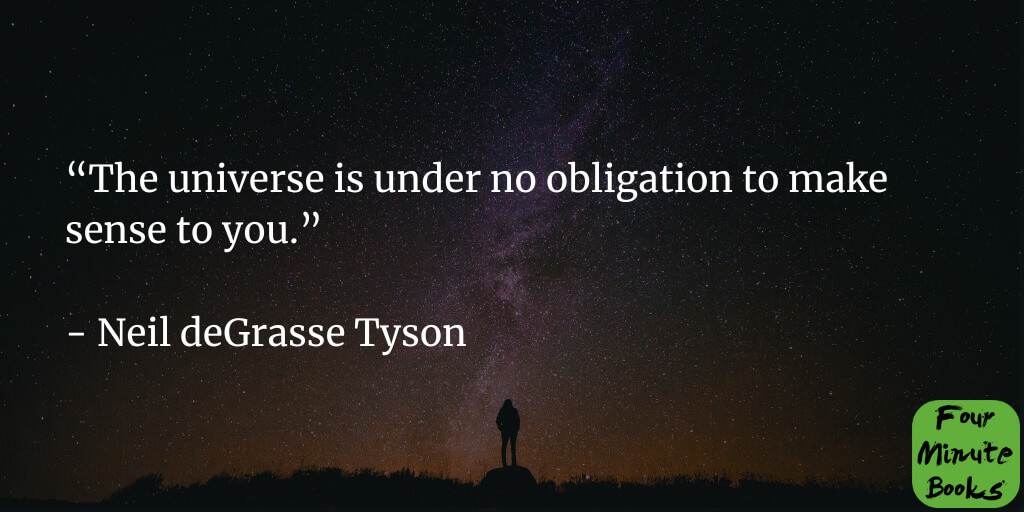1-Sentence-Summary: Astrophysics for People in a Hurry talks about the laws of nature, physics, astronomy, and the mysterious inception of our cosmos, the universe, stars, and implicitly our beautiful planet where life thrives and perpetuates.
Read in: 4 minutes
Favorite quote from the author:

Table of Contents
Video Summary

Astrophysics sounds like a complicated term itself, without getting into details about what it means or how you can understand it by studying the field. However, although it’s not too far from rocket science, there’s a way through which people like you and me can get an idea of what this science is.
Astrophysics for People in a Hurry by Neil deGrasse Tyson is like a one-to-one session with your favorite teacher. This book will help you wrap your head around considerably challenging concepts and learn about the universe, the stars, the planets, and life in general. This quick lecture proves that science can be fun too!
Although difficult to choose from, here are the lessons that are the most fun and useful for you to know:
- One thing that scientists know about the universe is that we don’t know much about the universe.
- Helium is a matter that was first discovered in the Sun spectrum, and not on our planet.
- We all emerged from a tiny dot that was once unimaginably hot, but then expanded and cooled down.
Science can seem like a difficult subject, but these lessons will help you start on the right foot and learn some pretty interesting facts about the universe. Let’s start with the first one!
Astrophysics for People in a Hurry Summary
Lesson 1: Modern science discovered plenty of facts about the universe, but there’s still a lot that we don’t know.
There’s one thing that scientists agree upon: we know that we don’t know. There’s only so much that science had discovered about the universe, our planets, the stars, and how life emerged. We know that the laws of physics have an effect on all these things, but we don’t know which effect that is.
We know that there is a lot of dark matter that is yet to be discovered, as only one-sixth of the mass in the universe is made of galaxies and gas clouds. Scientists still don’t know how to detect the rest of the mass, as we don’t even have the devices to recognize new matter.
In terms of how our planet came to life, we know that it happened through a small dot that expanded at a huge rate. Still, it took 380,000 years to have light separate from matter. 14 billion years have passed by, and stars emerged in the process, one of which is our precious Sun.
Lesson 2: Helium was discovered before it was found on Earth.
Helium might seem like a common, day-to-day matter, but it carries a very interesting story. It was first discovered in the Sun’s spectrum, way before it was discovered on Earth. A fun fact about it is that the word helium means Sun in Greek. Cool, right? Now back to our point.
Its discovery reveals interesting insights, such as that celestial matters operate under similar laws to ours. Newton found that too when he discovered the laws of gravity. Gravity is a universal law of nature, which means that it applies to outer space too.
The similarities we share with the universe can only make us wonder: What if there are other things we have in common, such as life? Are there aliens out there somewhere? If so, the Chinese people will be the first ones to know! They’ve built the biggest radio telescope on earth to study prospective aliens and discover them.
Lesson 3: The Universe started as a tiny, extremely hot dot, but then cooled off and expanded.
Before everything we know today came to life, the energy and matter that makes up the Universe, the galaxies, planets, stars, matter, and everything in between, was concentrated into a tiny dot. The dot exploded and started to cool off rapidly, giving way for celestial matter to form.
Essentially, that’s the story of the Big Bang. After the dot exploded, the forces keeping the dot condensed all separated, which resulted in gravity, the electromagnetic force, and the nuclear force. The matter then went on to become a bunch of subatomic particles (or electrons, neutrons, and quarks)
Everything started to cool off and make room for the matter to grow bigger and stronger than antimatter. Antimatter destroyed plenty of matter that existed in the universe at its inception (roughly between its first second to the first two minutes of its existence). During this time, helium and hydrogen grew abundant.
This process was essential for our future development as a planet and for life to emerge. When the right temperature came by and there was enough matter left, electrons captured protons, and atoms formed. Billions of years later, stars exploded in outer space, spreading carbon and contributing to the inception of Earth.
Astrophysics for People in a Hurry Review
Astrophysics for People in a Hurry is a fascinating piece of writing about the most captivating facts of science, life, the beginning of the universe, and many other laws of science. By combining physics, chemistry, mathematics, and astronomy, the book manages to shed some light on the most wonderful facts about life and the universe. Reading this book will help you wrap your head around some of the universal truths about life and science in general.
Who would I recommend the Astrophysics for People in a Hurry summary to?
The 30-year-old person who likes to read factual pieces about science, the 27-year-old who is trying to learn about science quickly, or the 22-year-old science student who likes to study the universe and its origins outside their curricula.
Last Updated on June 15, 2023